Jendouba. What a dump. There is only one hotel, it cost more than anything I have had so far in Tunisia (35TN), is nothing special and the guy only laughed when I asked if there was Wifi. I needed to withdraw money and they said it was so far, that I would need to take a taxi. That’s advice I have learned to ignore. It took me 10 minutes to walk there. Besides drinking espresso and smoking, this is not an exercise culture.
BULLA REGIA
Famed for its extraordinary underground villas, the Roman city of Bulla Regia (7TD), 7km northwest of Jendouba, offers a rare opportunity to walk into complete, superbly preserved Roman rooms – there’s no need to guess at how things once looked.
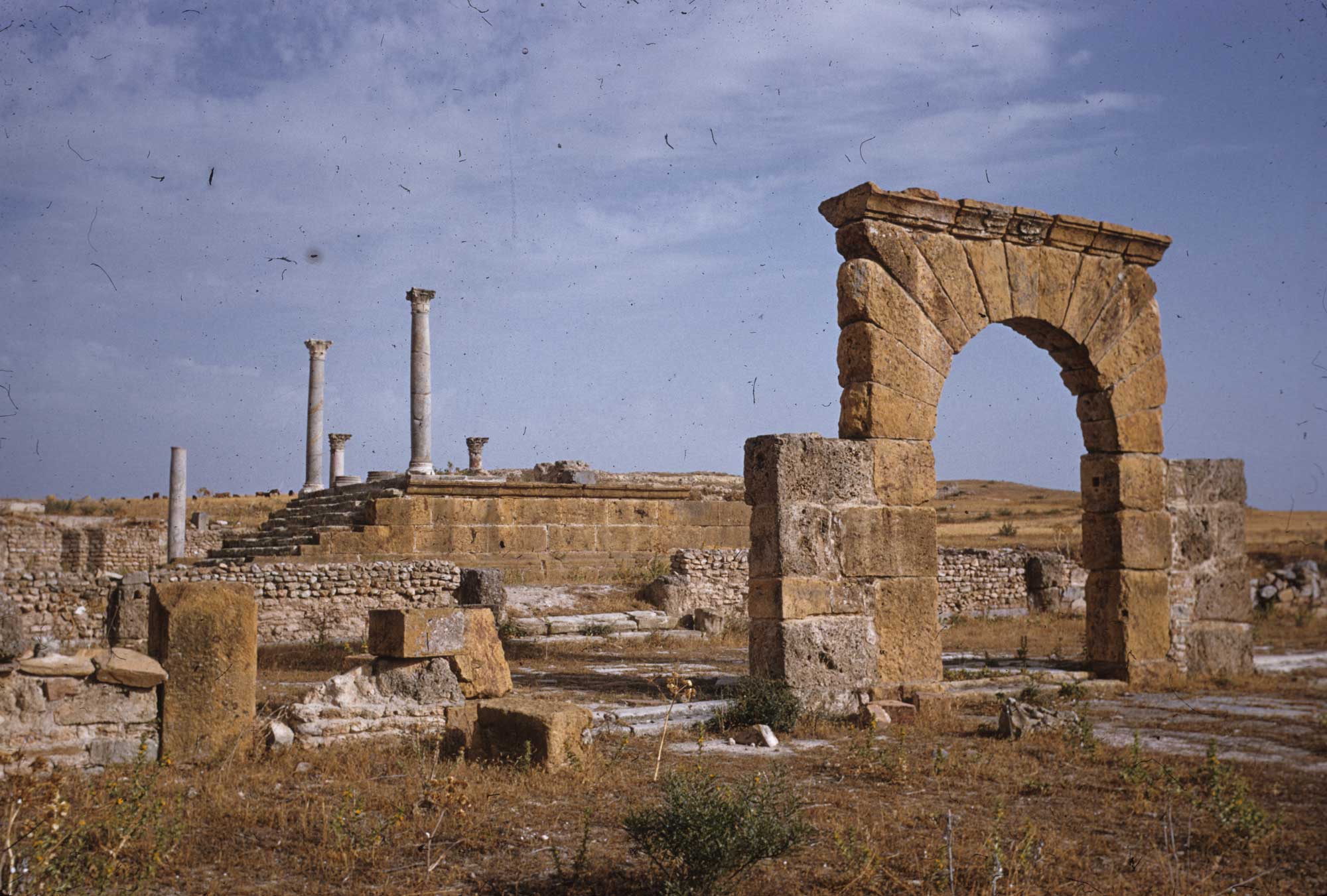
To escape the summer heat, the ever-inventive Romans retreated below the surface, building elegant homes – complete with colonnaded courtyards – that echo the troglodytic Berber homes at Matmata. The name each villa is known by reflects the theme of the mosaics found inside. Some (but not all) of the best are now in the Bardo Museum. Especially lovely examples can be seen at the oldest (though simplest) structure, the House of Fishing, which dates from the 2nd century.

The newer villas become increasingly more ostentacious. The star attraction is the House of Amphitrite, with its nude Venus and centaurs, and attendant cherubs riding dolphins.


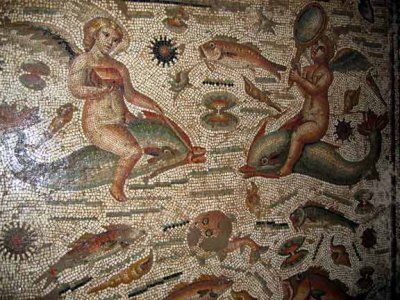
Bulla Regia is approximately 160km west of Tunis and may be easily visited on a day trip from Tunis, Le Kef or Tabarka. Trains or buses to Jendouba are your best bet to and from Tunis, and there are also regular buses and louages to and from Le Kef and Tabarka. A taxi from Jendouba costs around TD5. Any bus travelling between Jendouba and Ain Draham can drop you off at the Bulla Regia turn-off, from where it’s a 3km walk. In the summer, it can get very hot here.
There are no paper maps, but a map was just inside the entrance on the left. Without a map or guide, one would never find anything without a huge amount of searching. It is quite a big site and the only things visible from the road are a large building at the entrance and a theatre to the north. All the interesting stuff is on the western edge (consider the road as running north-south). Bring some paper and a pen and draw your own rough diagram to get any satisfaction from your visit. There were some men working, they hailed a fellow, who although only spoke French, gave me an excellent tour for free.
There are three underground spaces and two of them were disappointingly locked. The one that was open had several rooms and ok mosaics. To see the fantastic mosaics of the House of Amphitrite, we climbed a small wall, jumped down about five feet and got good views through a grate. Not much of the House of Fishing was visible down a round open well. There were several outstanding mosaics out in the open in the same area: a large floor with gazelles, a zebra and fish; a small pool with a man fishing from a boat and a spectacular bathtub with mosaic writing. Search this area carefully to find everything.
The rest of the site is simply broken walls, nondescript rooms and old stone roads.
The taxi out was 5TD (there is also a bus that runs on the hour from in front of the hotel). The taxi back was free (the driver picked up passengers along the way and a woman paid for me).
DOUGGA. 110kms SW of Tunis, and 1 hour from El Kef, Dougga is one of the most magnificent Roman sights in Africa. Its ancient remains are startlingly complete, giving a glimpse of how well-heeled Romans lived, with baths, the imposing Capitole (the 3500-seat theatre) and 21 temples (one had immense walls – the Romans were incredible engineers. The city was built on the site of ancient Thugga, a Numidian settlement, which explains why the streets are so uncharacteristically tangled. The 2nd-century-BC Libyo-Punic mausoleum is the country’s finest pre-Roman monument.
Dougga can easily be visited on a day trip from Tunis or Le Kef – or en route between the two cities. Built of tan stone on a hillside, it blends with the dusty landscape of the Kalled Valley and Tebersouk Mountains.
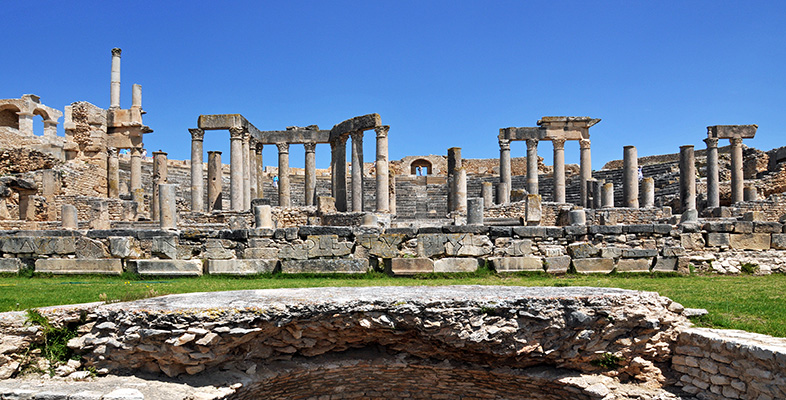
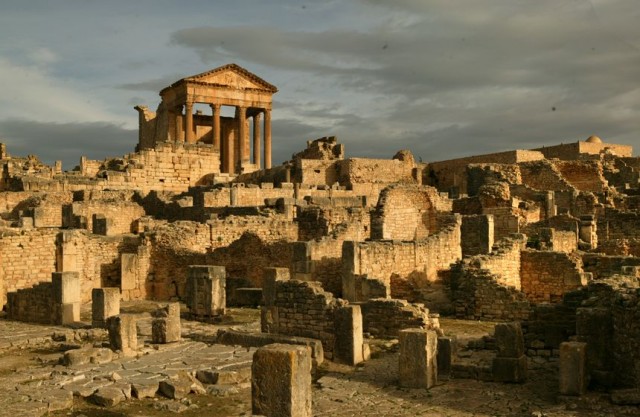
If coming from Tunis, buses and louages stop at Tebersouk, about 8km northeast and then hire a louage or taxi to Dougga. If coming from El Kef, turn at Nouvelle Dougga. The best time to visit is in the morning or late in the day; allow at least three hours and pack a picnic.
I arrived at Nouvelle Dougga (pop 400) from Silyana on the regional bus at 1:15pm. A taxi promptly offered for 20TD to drive me the 3km north uphill to the ruins (7TD) and I took 70 minutes to see everything. Wow, very special, especially the theatre and the large temple. I wish I could read Latin as the perfectly incised text was everywhere. Remnants of mosaic floors were common. If the place had a map or signs, its value would have been considerably enhanced. Besides a few workers and 4 local tourists, I had the place to myself. The driver waited for me and took me the 8km to Tebersouk to get the 3pm bus to Jendouba where I hoped to sleep in order to see Bulla Regia the next day. Some transportation finally worked out.
EL KEF. (pop 41,600)
3 ¼ hours SW of Tunis by bus and 1 hour past Dougga, this proud, well-kept city is a real gem. The medina is a hilltop of narrow cobbled streets and blue-shuttered buildings, both traditional and early colonial in style. Highlights include beautiful ancient Muslim, Christian and Jewish places of worship.
Kasbah. Fortress that dominates the city and has great views looking out across the rolling blue-green landscape dotted with trees. A stronghold of some sort has occupied this site since the 5th century BC.

Zaouia of Sidi Boumakhlouf. Enchanting 17th-century Sufi mausoleum, with a brilliantly tiled interior and narrow tower.
Musée des Arts et Traditions Populaires. Well-laid-out museum, housed in a sprawling, ornate Sufi complex founded in 1784. The museum concentrates on the culture of the region’s Berber nomads.
Jugurtha Tableland is a large mesa near the town of Kalaat es Senam (due west of Kairouan that stands almost 600 metres (2,000 ft) above the Ez-Zghalma plain. 1,500 m (4,900 ft) long and 500 m (1,600 ft) wide, it covers a total area of nearly 80 hectares. Geologically an inverted relief, the hard limestone top of the mesa was left after the softer surrounding hills were worn away by erosion.
The mesa has been used as a fortified site several times in history, as its height provides a clear vantage point for defenders, and the sheer rock walls make ascent difficult for attackers. Legend holds that Masinissa, the first king of Numidia, built the first fortress there around 200 B.C. Around 112 to 105 B.C., King Jugurtha of Numidia used the mesa to hold off the Roman legions in his long war with them.
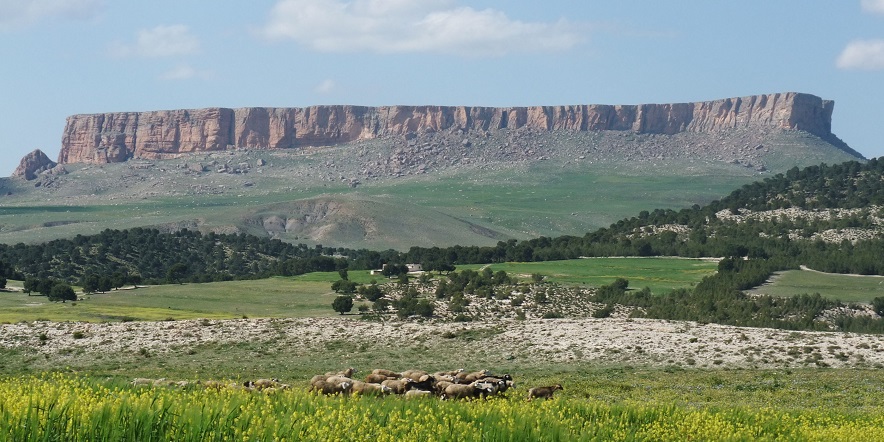
Tamerza & Waterfall. North of the salt lakes, near the border with Algeria, 6km from Mides and 70km from Tozeur, it is the largest mountain oasis in Tunisia, known as Ad Turres by the Romans. Surrounded by steep and wild area country, it has springs from the nearby hills that irrigate the town, a canyon and an old town abandoned after the river flooded for 22 days in 1969.
SOUTHERN TUNISIA
TOZEUR (pop 35,500)
An excellent base to see Chott el-Jerid, Tunisia’s largest salt lake, you can also get excursions via 4WD to Ong Jemal, a dramatic location used in both Star Wars and The English Patient; Nefta, with its exquisite sunken palmeraie; or the beautiful Berber villages of Midès, Chebika and Tamerza.
Ouled el-Hadef. This 14th-century medina has a unique, striking architecture of pale brickwork arranged in relief patterns. Much different from the Tunis Medina, this has few shops and no people, but instead long lanes of artful brick work and closed colourful doors.

I visited one shop jammed full of stuff and chatted with Said, the ancient owner. Since the Sousse terrorist attack, tourism has been completely dead and he was eager to sell me something. I admired some silver bracelets and the bargaining was on! He gave his price, I gave him mine and we met in the middle (I was wary of the trap he set for me as I couldn’t walk away with nothing once the process started). But I had real empathy for the old guy. The first floor of his shop is huge and full, the second is all carpets and the third is a coffeeshop and panoramic rooftop with views down to the medina and palmeraie.
Dar Cherait Museum. This private museum in the Dar Cherait Hotel has exhibitions depicting life from the poor to the wealthy. The personnel here wear traditional costume.
Palmeraie. Enormous gardens with over 200,000 date palms.
I went on a walk-about and saw an awful lot of the town. I regret not going to see the Berber villages as they all looked enchanting but the prices quoted were exorbitant.
Chott el Djerid (“Lagoon of the Land of Palms”) is a large endorheic salt lake in the centre-west of the country, between the cities of Tozeur and Kebili, the largest salt pan of the Sahara Desert, with a surface area of over 5-7,000 sq. kms. The bottom is 10-25m below sea level; it is 250 kms long and as narrow as 20 km. Appears in various shades of white, green and purple. It has a typical hot desert climate with annual rainfall below 100 mm and daytime temperatures sometimes reaching 50 °C. In summer Chott el Djerid is almost entirely dried up, and numerous fata morganas occur.
South of Chott el Djerid are the towns of Kebili and Douz and the Grand Erg Oriental desert begins. The lake can be crossed by foot and even by car, but this is very dangerous since the salt crust is not always firm. During winter, when the lake is full, it can be crossed by boat. Piles of salt at its edges are collected for salt production processing.
Relict populations of the West African crocodile persisted in the Chott el Djerid until the early 20th century. Pink flamingos nest in springtime.
The dunes of the Grand Erg Oriental, one of the Sahara’s most expansive sand seas, spill into Tunisia’s far south. Life-giving palmeraies support a network of busy oasis towns, and produce an autumn harvest of the world’s best dates. Beyond these, salt lakes and ruined Berber forts stare from scrubby hilltops. Back on the coast, the palm-dotted island of Jerba is an intriguing mix of ancient traditions, both Berber and Jewish, and beach-resort languor.

Tunisia’s sensuous Saharan dunes set the scene in The English Patient and its impressive fortifications served as a backdrop for Monty Python’s Life of Brian. But its most famous screen role was providing the otherworld architecture and desertscapes that gave the Star Wars series such a powerful visual identity. If you want to walk in the steps of R2-D2, hotels and travel agencies in Tozeur or Douz can organize tours of various locations or rent a vehicle and drive from Matmata to Tataoine to see many more.
Douz (pop 28,000), a modern, functional oasis with camel trading and riding, and a palmeraie with 400,000 date palms. Douz is the most convenient place to get a taste for the Sahara with the desert proper starting 80km south at the Grand Erg Oriental. It is south of Tozeur.
MATMATA. (pop 1500)
From above, the troglodytic pit homes that have made Matmata famous, look like bomb craters. Home to only about 20-25 families in Matmata now, the ingenious dwellings only come into focus up close and are a testament to humankind’s urge to domesticate, even somewhere as inhospitable as here. There are possibly 700 troglodyte homes in the area and many are still occupied. They are totally excavated by hand – a big round pit 12-17m deep is dug and rooms created in caves around the perimeter. They offer year-around climate control: in the 40-45°C summer heat, they are 20-25° and the winter are warm.

More recently, the town has drawn its fame from playing the home planet of Luke Skywalker in Star Wars.
The only place to stay listed in the LP was the Hôtel Marhala, a troglodytic hotel but it was impossible to make a reservation through the website of the Touring Club de Tunisie. But I was hustled by Mostafa at the louage stand and he took me to the Hotel Sidi Idriss and it turned out to be a good choice, although not recommended in the LP for accommodation. But ownership has changed since then and the place has been totally renovated. The famous Sidi Driss was used for interior shots of the Lars family homestead in Star Wars and was used again in The Phantom Menace and Attack of the Clones. The dining room is where Luke tucked into a blue milkshake and went head to head over the harvest with his Uncle Owen. It has all sorts of pieces left over from the original set – plastic doors, door frames made to look like brick and pipes coming randomly out of the floor and walls. I can’t wait to resee the movies.

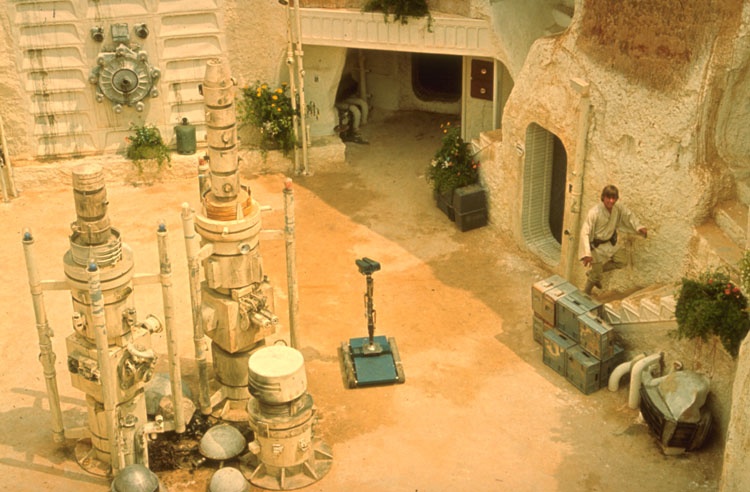
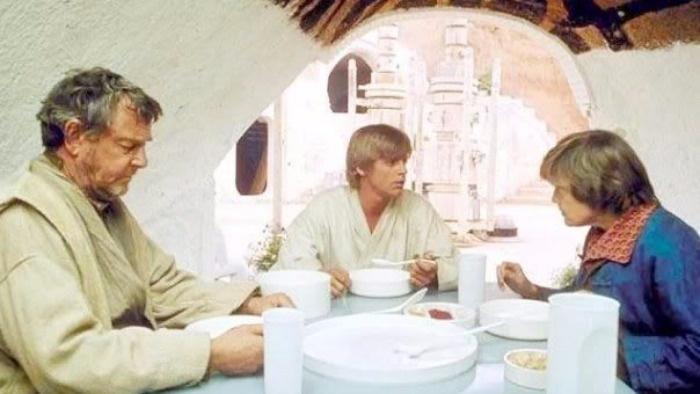
Scenes from Star Wars Episode IV: New Hope

Half pension (dinner and breakfast) was 25TD ($12.50) and beer 2.5TD. It is an incredible place with 3 open pits connected by tunnels and 25 rooms coming off the sides of two of the pits.
I had not come originally to see Matmata and pit homes, but for the New Years Celebration on January 16th at Temezret. A couple at the hostel in Tunis told be about it and it seemed a perfect way to leave Tunis, head for the south of Tunisia and see a festival in a small mountain town.
There were no louages or buses to Temezret and I was offered rides for 60TD, then 35TD when I offered to recommend to Lonely Planet this hotel and then 20TD by the manager who was quite friendly. All seemed a little high.
I was also hustled by a guy in the hotel offering tours to Berber villages, the Sahara, Tozeur, Douz and Tatouine, all places I wanted to visit. But the price was also high, 500TD (250$) for a 2-day/1-night trip.
He took me for a walk around the neighbourhood showing me his original troglodyte home now unoccupied, plus two others. Most people have now moved out into “normal” above ground homes. Homes all have small fields diked with berms of dirt. Likewise all the watercourses have dirt berms and rock walls across them to control water flow on the few days of rain in the winter.
On January 16, I woke up to a cold, windy, rainy day, not a good day to spend at a festival. After a breakfast of the usual bread, butter, jam and very black coffee, the persistent Mostafa Moncef, who had hustled me at the louage stand taking me to Hotel Sidi Idrisse, coaxed me into a day-trip to see all the things I was interested in. Still expensive at 250TD, I would get to Tataouine and on the way see several Berber villages that would require individual taxis and difficult logistics. He spoke passable English and served as a good guide and driver. Rather than the guide available through Sidi Idrisse, I would highly recommend Mostafa. He can be reached at (216) 97902239 or (216) 25921077 or by email at gnouma_moncef@yahoo.fr.
Prior to 5 years ago (and the revolution), there were many more tourists in Tunisia but perceptions are that it is not safe (and the recession has probably also had an affect), and tourism is relatively dead. The two ISIS attacks in Tunis at the Bardo and a hotel in the last year were particularly damaging.
Temezret (pop 500 with 35 families)
We started by taking a detour to Temezret, a Berber village in the south-east of the country, 10kms from Matmata and 40kms from Gabes. It is built on a hill 460m high above sea level, topped by a mosque and a café. Located on the national road 20 linking Matmata to Douz , it is very popular with Saharan tourist circuits. 500 people live permanently, this number can be multiplied by ten in summer and during school holidays. The economy is based on tourism and agriculture (goats). Only Tamezret still hosts Berber-speaking residents .
The tiny town sits on a hilltop with old stone walls and mostly abandoned stone homes on the top. We did a walk-about though the town – it only took 20 minutes to see all that was interesting and I didn’t regret missing the festival (only in its second year, it celebrates the Amazir Berber culture and looked to be a very low-key, local affair). These Berbers were Christian before conversion to Islam.
Returning to Matmata, we headed south through rocky, hilly countryside averaging 800m elevation high with panoramic views down to the plain below. The road was slow and winding with low scrub vegetation and a few olive trees.
Toujane (pop 800 with 150 families)
We stopped at a restaurant/shop high above the 300-year-old town of stone houses spilling down the hillside on either side of a wadi. The bleating of goats and sheep carried up the hillside. The town is famous for carpets made from sheep and camel wool and I almost bought one. The small ones with traditional motifs in natural dyes take a month to make and were only 70 TD but were simply too bulky to carry in my limited pack. But I bought a lovely silver bracelet for Anna.
Ancient abandoned terraces covered the slopes.

Ksar Hallouf
We detoured west to visit this small amazing village. Up a steep, 4WD road, the old part of the town has been uninhabited for 60 years. About 100 stone, two-story, round-roofed structures, each perhaps 20m X 2m surrounded a large open area on the top of the hill. A very affable guy spoke only French but made himself well understood and guided me through several homes, a mosque (plastered geometric designs and Koran verses), the school (plaster fish, hands, geometric designs adorned the ceiling) and the olive oil press. A donkey or small camel walking around the 2m wide press pushed a huge round stone. Panoramas of the modern town below circled the old place. I gave him 10TD for the tour that the driver thought appropriate.
Donkeys and people carried bundles of olive branches for sheep feed. A dinosaur stood on top of one hill.
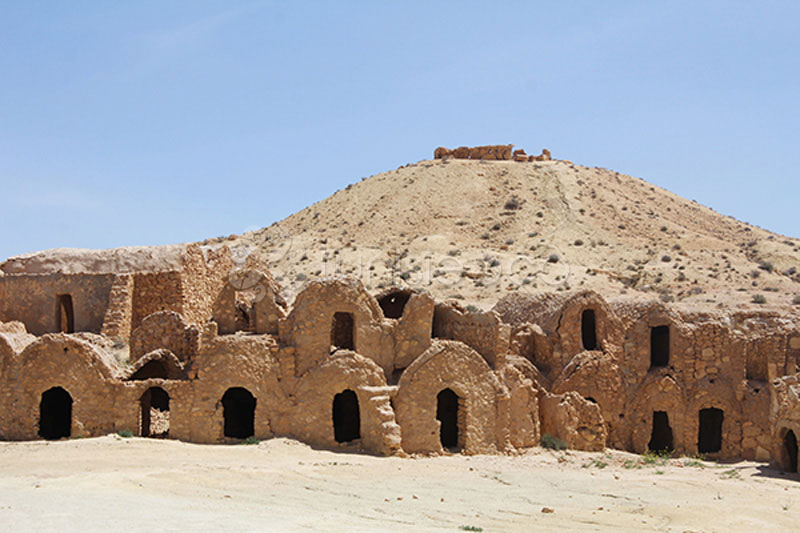
Ksar Hedada
This village was the location for the Mos Espa slave quarters – stunningly weird architecture, a warren of disjointed lanes of structures identical to Ksar Hallouf: other-worldly, two-story, round roofed structures little more than a meter wide and up to 10m long is where, in the “restaurant”, Qui-Gon Jinn learned the truth about Anakin’s parentage in the 1997 The Phantom Menace.


Where we stopped for lunch, the Berber dress was a brown cloak with a wide hood.
Guermassa
Set on a high hill under two rock pinnacles, this village consisted of terraces of caves fronted by stone walls and buildings. A great olive oil press was in one room. These Berbers were Christian before converting to Islam. It was abandoned about 65 years ago for the modern town below.
Chenenni
The town itself is a series of stone houses fronting caves set on several terraces and covering the top of the mountain – it was incredibly picturesque. A white-washed mosque sat in the saddle below.

The Mosquee des Sept Dormants (Mosque of the Seven Sleeps) is on a hillside outside the town. Built 700 years ago, it was a Christian Church before a mosque and is surrounded by the graves of Christians (the 8 graves are 5m long as the people were much bigger then!!) and several Berber graves. It is a gorgeous little structure with 7 small domes and a leaning tower capped with a triangular structure. It was locked as there are no tourists and people were using it to sleep in. Next is a cave lived in for 390 years that predates the church/mosque.
TATAOUINE (pop 90,000)
Not a destination in itself, this big city is best used as a base for exploring the ruined hilltop ksar (fortified strongholds) that I have just seen on the way from Matmata. I simply passed through after seeing Chenenni and on my way to and from Ksar Ouled Soltane.
Here the Berber dress is simply a big brown cape like a blanket draped over the head.
Ksar Ouled Soltane
22kms SE of Tataouine, these were more slave quarters in some of the Star Wars movies and are perhaps the finest example of the curious moulded courtyard-centred buildings, actually ghorfas or ancient grain stores. Walk initially down a “street” of 1, 2 and 3 story ghorfas before entering a large courtyard surrounded by 50 ghorfas, most a dizzying 3 and 4 storeys high, reached by precarious dream-sequence staircases. The store rooms had creaking old doors and a few giant pots hanging through the doorways.
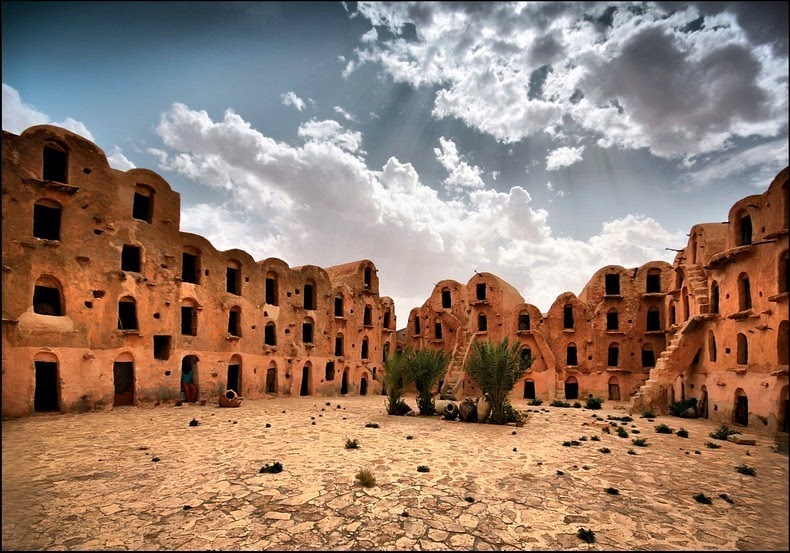

Was it worth spending 250TD (125$) for a one-day drive? It was the only way to see all these villages and Star Wars sites and I passed through a lot of pretty countryside in the mountains along the way. One place I intentionally missed (but should have included as it would not have cost more) was Ksar Gelan, an oasis with a warm pool for swimming and the opportunity for camel rides. And I also saved at least two days of travel. I think I spent a few days too many in Tunis and now was in a bit of a rush to see the rest of Tunisia. I had set my sights on the cheapest flight to Beirut, on TunisAir on Sunday, January 24.
After a great day, Mostafa (on his way back to Matmata) dropped me off at the louage station in Medenine, north of Tataouine and the crossroads to Jerba and its capital city Houmt Souq, my next destination.